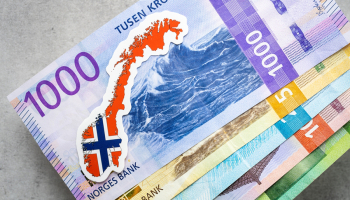Norway’s Multi-Billion-Dollar Private Equity Plan
The Norwegian sovereign fund is set to invest part of its portfolio in private equity for the first time, with a potential total investment of more than $44 billion
- |
- Written by Banking Exchange staff

One of the world’s biggest sovereign wealth funds is exploring its first venture into private equity, with a potential allocation of around $44 billion, according to government documents.
The NOK15.8 trillion ($1.5 trillion) Norwegian Government Pension Fund — Global (GPFG) has traditionally been restricted by government regulations to investing in listed equities and bonds, with real estate and renewable energy allocations introduced in 2010.
However, after years of discussion, Norges Bank — Norway’s central bank — has proposed investing between 3% and 5% of the overall portfolio into unlisted equities. This could see between $44 billion and $73 billion deployed in the asset class over the next few years based on the fund’s most recent valuation.
Documents published by Norges Bank last week indicated that a 3% allocation was possible without having a substantial negative impact on the fund’s current volatility limit.
Ida Wolden Bache, chair of Norges Bank’s Executive Board, said in a statement last week that adding unlisted equities “would be a natural evolution of the investment strategy”.
“An increasingly larger share of global value creation takes place in the unlisted market,” Bache added. “We believe that such an opening could give higher returns for the fund over time. We think it will be possible to invest in unlisted equities in a way that meet our expectations on transparency and responsibility.”
It cited data indicating that the number IPOs was falling year on year, and the listed equity market “has not grown beyond what can be explained by movements in share prices”. The GPFG’s size means it has a stake in almost every listed company on the planet, so trends such as this are of particular interest to its management team.
Norges Bank’s subsidiary, Norges Bank Investment Management (NBIM), is responsible for the investments of the GPFG. It must wait for approval from Norway’s Ministry of Finance before beginning to invest in the new asset class.
NBIM said it would “approach investment opportunities and build competence gradually”, as it has done previously when building up the GPFG’s allocation to real estate.
Ensuring good governance
This will not be the GPFG’s first venture into unlisted assets. It has been investing in unlisted real estate since 2010, and a year later was given permission to invest in unlisted equities if the companies were soon to seek a stock market listing.
In 2020 the GPFG was given permission to invest in unlisted renewable energy infrastructure and made its first investment earlier this year with the purchase of a €1.375 billion ($1.5 billion) stake in an offshore wind farm.
Norges Bank said it would “be able to draw on experience from its existing unlisted investments”, including its previous work on partnership agreements, structuring ownership, accounting, risk management, tax matters, regulatory compliance, and reporting.
In particular, the central bank praised the work of US pension funds in improving the transparency of private equity as an asset class.
“Large international funds emphasise transparency and responsibility and have driven improvements in these areas in recent years,” Norges Bank stated in a letter to the Ministry of Finance.
“US pension funds have been the driving force behind disclosing the names of portfolio companies that private equity funds are invested in. This is now standard practice for large, established private equity funds.”
Balancing risk and return
Research cited in Norges Bank’s correspondence showed that the average investor in private equity buyout and secondary strategies “achieved higher net returns than for listed stocks” between 1985 and 2023.
While such returns could not be guaranteed, Norges Bank said the GPFG’s size and reputation may help ensure that the fund experiences better than average performance over the long term.
“The fund’s size and long investment horizon, as well as the GPFG’s reputation for responsible investments, may bring access to the most renowned managers,” the central bank stated in its correspondence.
“Furthermore, our costs will probably be lower than for the average investor, both through lower fixed management fees and better access to co-investments where no fees are normally paid.”
The GPFG is managed within a strict volatility limit across the whole portfolio, with volatility measured relative to a bespoke benchmark. Norges Bank calculated that it could build up a private equity portfolio of approximately 3% of the overall fund without threatening this volatility limit.
Tagged under Buyside Exchange, Pension Funds, Private Equity,
Related items
- Market Volatility Creates Bigger Role for Active Managers
- CPP Ends Q1 on a High with Positive Returns
- Wall Street Looks at Big Bank Earnings, but Regional Banks Tell the Story
- CRS Report Highlights Regulatory Obstacles for Pension Plans
- Private Equity Managers Urged to Adjust Value Creation Approach













